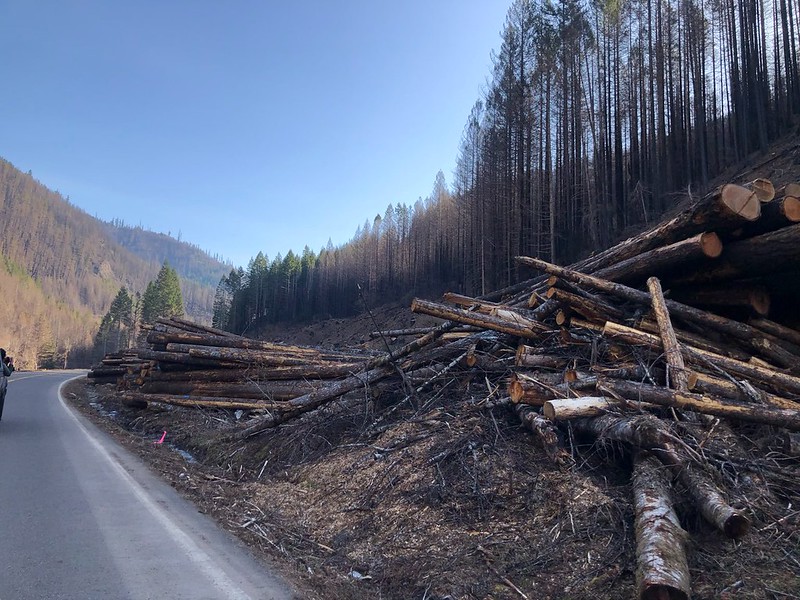
Hazard tree removal along Forest Service Road 46 near Detroit, where the Lionshead Fire burned more than 200,000 acres.
Courtesy of Cascadia Wildlands
Conservation groups are suing the U.S. Forest Service over its plans to log along hundreds of roads in the Willamette National Forest that burned in last year’s wildfires.
The agency says the Beachie Creek, Lionshead and Holiday Farm fires created dangerous conditions on 404 miles of forest roads that are needed for forest management and recreation but are now closed for public safety.
Willamette National Forest Supervisor Dave Warnack approved a plan earlier this month to remove dead or injured trees — referred to as hazard trees — along all of these roads without reviewing the environmental impacts of the logging.
“This project provides a vital first step to reopen fire-burned areas so we may move forward with fire restoration and repair and help the landscape recover,” he said in a statement.
Nick Cady with Cascadia Wildlands said the plan is too broad and doesn’t consider any of the impacts that potentially extensive logging would have on nearby rivers or endangered species.
His group filed a lawsuit on Wednesday along with Willamette Riverkeeper and Oregon Wild asking the court to order the Forest Service to do an environmental analysis before cutting burned trees.
“This is like the most degrading type of logging that can happen,” Cady said. “That logging needs to be targeted to areas that actually need logging and not just broad, 200 foot clearcutting on 400 miles of roads.”
The Forest Service did not immediately respond to requests for comment.
In his decision memo, Warnack said that the logging will remove all of the “danger” trees within one tree length of the roads but will leave “danger” trees that don’t threaten roads, property or infrastructure. He emphasized that not all of the trees along all 404 miles of forest roads will be logged.
“These roads have varying levels of fire-killed or injured trees depending on how severely the fire burned in the area,” Warnack wrote. “There are road sections where there are no danger trees, others with scattered individuals or small groups of danger trees, and more where all trees within striking distance of the road were killed by the wildfire.”
Cady said the project could result in logging thousands of acres of forestland, and would ultimately allow contracted timber companies to decide which trees to cut. Without an environmental analysis, he said, the Forest Service doesn’t know which areas are most in need of hazard tree removal and where logging burned trees could create environmental problems for nearby drinking water systems, threatened and endangered salmon or northern spotted owls.
“I think the Forest Service is thinking. ‘Hey, we can generate a lot of timber volume and make a lot of money, and if there are any public safety issues this is going to deal with it,’” Cady said. “The problem is you’re going to log a bunch of areas that don’t need it. They’re just broadly authorizing logging.”
In his memo, Warnack said the money generated from timber sales would help offset agency and taxpayer costs and could be used for watershed restoration and reforestation.
“The sole purpose of this project is to fell danger trees alongside roads that are hazardous to travel and reopen them while reducing the risk to public and employee safety,” Warnack wrote. “The purpose of this project is not timber production; this is not a salvage harvest.”
Cady said some of the roads authorized for logging are functionally closed and don’t need to be logged for public safety.
“Our goal is to focus the Forest Service on areas that actually need hazard tree logging, roads that are actually traveled by people,” he said.
In his memo, Warnack argued that the project doesn’t require an environmental analysis under federal “categorical exclusion” rules that allow the agency to repair and maintain roads without doing environmental reviews that are normally required under the National Environmental Policy Act.
“The potential impacts of project activities to federally listed or Forest Service sensitive species are not significant and do not represent an extraordinary circumstance that would preclude the use of a categorical exclusion because the project was designed to minimize or avoid impacts to these species,” Warnack wrote.
Cady said the amount of logging authorized in this project is far beyond what would typically require an environmental review, and that normal forest road maintenance wouldn’t involve so much tree cutting.
According to the Forest Service plan, roadside logging will begin as soon as tree removal contracts are in place, and the work will take several years to complete. Cady said his group will ask the court to stop the logging from moving forward while the lawsuit is pending.


